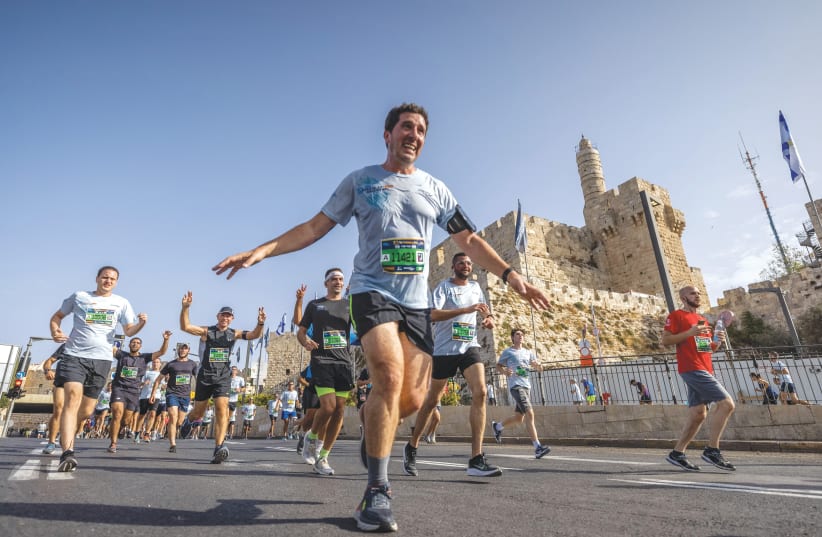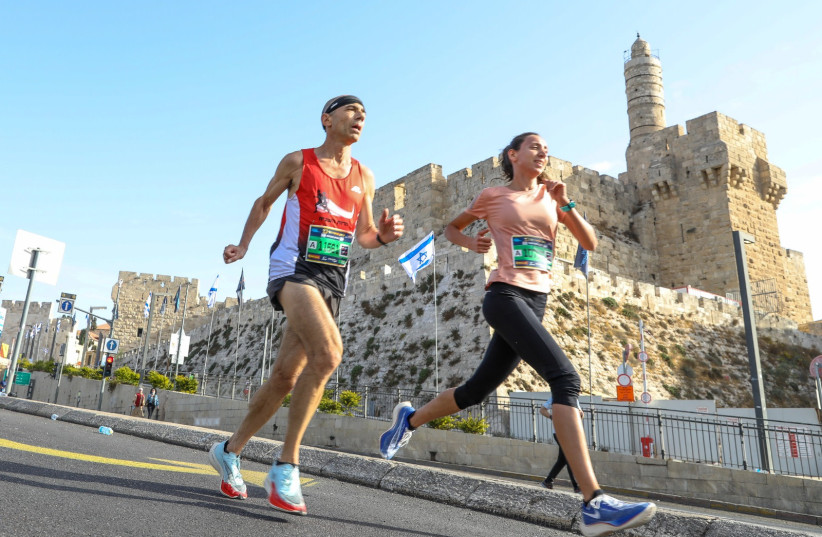About 20,000 people ran between the Knesset, along the Old City walls, the Sultan’s Pool, Mishkenot Sha’ananim, Mount Zion, the German Colony, Rehavia, the Commissioner’s Palace promenade, Ammunition Hill, Sacher Park, Mount Scopus, the Mount of Olives and other sites. The first to finish ub the 10th Jerusalem Winner Marathon men’s race was Aymaro Almiya, a 29-year-old Jerusalemite, with a result of 01:07:52, who broke an Israeli record. Among the women, first place went to Anna Price, 45, with a time of 03:25:50. The female victor of the half-marathon was Bracha (Beatty) Deutsch, a famed haredi mother of five and past Israeli champion, with a result of 01:20:40.
This year, for the first time, Mayor Moshe Lion also participated, and on the occasion of the 10th marathon, he ran the 10K with the number 10 on his shirt.
Lion congratulated the marathon runners and invited all for the next marathon in March 2022.
More towers
The municipality, through the local planning and construction committee, has approved a new construction plan the Gilo neighborhood. Focusing on Rosemary Street, where the light rail will run, the plan has the 183 current housing units increasing to a total of 800 units, in a complex of two 35-story towers and two 17-story buildings. The towers’ ground floors along the light rail will be commercial, with about 2,200 sq. m. of public buildings.
This is one more project in the municipality’s extended plan to expedite the construction of urban renewal projects to increase apartment supply, “combined with a proper infrastructure response to this increase.” In other words, everywhere possible, new towers will replace existing buildings – without any sign of prices dropping.
Hop on the bus
As of today (Friday, November 5) Superbus, the newly operating bus company in the city, will launch its second phase in central Jerusalem. These are changes and innovations being carried out as part of the tender terms promoted by the Transportation Ministry through the Master Plan for Transportation, which Superbus won half a year ago. To the first four service lines already existing in the city center – 136, 83, 82 and 38 – a new high-frequency tourist line (line 2) will be added, serving as a circular route to tourist sites in the Old City area and the Western Wall. This line – which begins its route in the Karta parking lot, through the Jewish Quarter and the Western Wall – has received an impressive response from Jerusalem residents and those who come through its gates.
More lines will be added in the coming months, as Superbus is gaining its share of the capital’s mass transportation following more than 50 years of an Egged monopoly, which has now come to an end.
Education and happiness
The Municipal Education Administration (Manhi) has launched a program to promote organizational happiness for city educational staff. Training will be provided to principals and school program coordinators to equip them with tools to promote a sense of meaning, belonging and enjoyment.
Following the challenging coronavirus period, the importance of engaging in the mental well-being of educational staff was reinforced. As studies show that workplaces promoting organizational happiness benefit from a decrease in the rate of employee absenteeism, a low turnover rate, and an increase in entrepreneurship, creativity and satisfaction, it was clear that at some point this program would be instituted here. For now, there is no such training for students who have been exposed to the same challenges, but time will tell.
Unwieldy process
The mechanism for tax deductions in the municipality is very cumbersome – so say the Hitorerut list members at city council. And at the last city council meeting on October 28, they presented a motion to improve it.
According to Adir Schwarz, the Hitorerut member who presented the motion, there are about 180,000 tax rebate applications submitted every year, and the municipality has difficulty dealing with the largely outdated system used by the Assessing and Collection Division. For example, the Tax Administration (Arnona) at Safra Square is required to scan the forms one at a time and re-upload them to the municipality’s website.
As a result, the average time to respond to each application is between four to six months, too long of a wait, especially when compared to other municipalities in the country, added Schwarz. Moreover, the means of payment and the requests for a tax rebate are not accessible enough to all residents, which makes it especially difficult for shared apartments – with the result that many residents’ rights are violated.
Schwarz and his list proposed some possible alternative solutions to the current payment method, including the option of a bimonthly payment, and the “personal area for resident” function, which is already practiced in most major municipalities in the country.
Stay tuned to learn the municipality’s next step.
The sky’s the limit
A nice initiative of three Pisgat Ze’ev residents in partnership with the local council, which has enjoyed municipal support and funding, culminated earlier this week in the launching of an observatory and telescope site in northern Jerusalem. The municipality inaugurated the Kochbia – from the Aramaic world for stars – Observatory in Pisgat Ze’ev as part of a larger project to save and develop the natural park around Nahal Zimri (a seasonal stream passing through the neighborhood, at the center of a major project by residents and environmental activists). The observatory is located in the Kraus parking lot in Pisgat Ze’ev, in a location chosen for its relatively clear light, and will include a portable telescope and binoculars. The site will be used as a community meeting place, hosting classes, workshops and more.
Fly us to the sky
For the first time at the Biblical Zoo, starting this month, visitors will have the opportunity to take in a display of biodiversity and a tropical butterfly house.
In this microcosm of a tropical butterfly forest, about 15 species of tropical butterflies will fly freely among the visitors; four complexes will show the wide variety of large and small animals existing in the system.
What now in Sheikh Jarrah? Residents of Sheikh Jarrah earlier this week rejected the compromise proposed by Supreme Court justices that would define them as protected tenants and hence enable them to stay in their homes. In return, they had to deposit a low rent to the right-wing organization Nahalat Shimon, which owns the plot.
Sources inside the group of families admitted that in recent days, internal tensions have risen between opponents of the proposal and its supporters within the neighborhood. The reason these families decided to finally reject the court’s proposition is that they fear making a payment, which is perceived as recognition of the settlers’ ownership of the houses, will erase what they consider their national rights on the plot. Sources say that talk among the Palestinian families was that if they accept paying the settlers, then they are traitors; hence, despite the proposition enabling them to remain in the houses until the end of their lives, they refused the offer. The proposal was presented in August by three Supreme Court justices, Yitzhak Amit, Dafna Barak-Erez and Noam Solberg.

